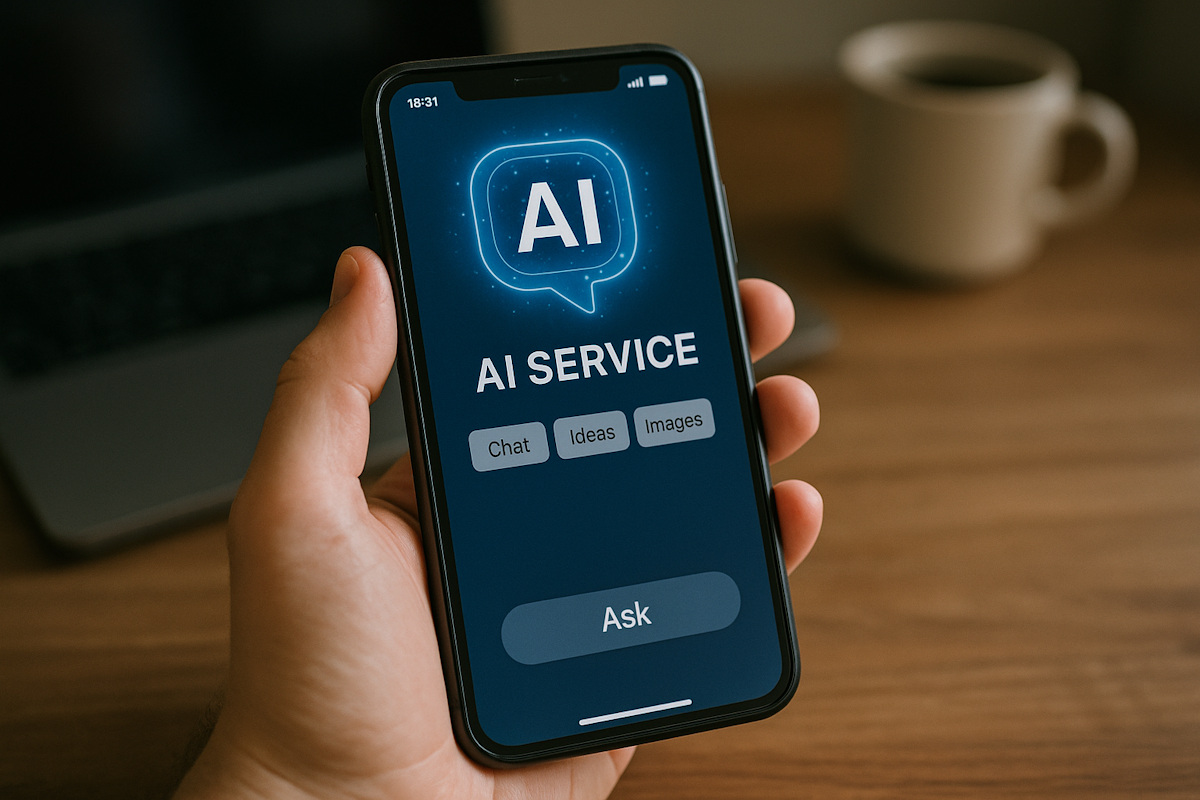AI as a Service

Artificial intelligence once required custom data pipelines, large research teams, and racks of GPUs. AI as a Service (AIaaS) removes those barriers. By exposing pre‑built models and managed infrastructure through pay‑as‑you‑go APIs, a business can add advanced capabilities to existing products and workflows in days, not quarters. This article unpacks what artificial intelligence as a service really delivers, why the market is expanding so quickly, how to choose an AI service provider, and the practical steps that lead from pilot to production.
What is AIaaS?
AIaaS (also known as artificial intelligence as a service) is a cloud delivery model in which the provider hosts, maintains, and updates the entire AI stack - data pipelines, model training, inference infrastructure, and MLOps tooling. Clients consume that intelligence through web endpoints or low‑code SDKs and pay only for what they use.
Three layers dominate most catalogs:
Ready‑made APIs
These are plug‑and‑play endpoints for vision, speech, translation, forecasting, recommendation, and generative text or images. A developer sends data, receives predictions, and ships a feature without hiring data scientists.
Custom Model Hosting
When off‑the‑shelf accuracy or brand tone is not enough, the provider lets you fine‑tune or train models on proprietary data, then deploy them on autoscaling infrastructure that the vendor maintains.
AI Platforms and Toolchains
Beyond inference, mature providers supply data‑labeling services, feature stores, continuous evaluation dashboards, and governance tools. This layer turns one‑off prototypes into repeatable, audited operations.
Why the AI Market Keeps Expanding
Multiple forces are pushing AIaaS well beyond early‑adopter territory.
High Demand
Analysts peg the 2024 market at roughly $16 billion and expect it to top $105 billion by 2030 - a 36% compound annual growth rate. That trajectory is unusual even for cloud software and signals enduring demand rather than hype.
Cloud Maturity and Falling GPU Barriers
Hyperscalers already operate the networking, security layers, and global points of presence that AI workloads need. Once those platforms standardized high‑end GPUs and multi‑tenant security, adding AI endpoints was a minor incremental cost for them and a major convenience for everyone else.
Generative AI’s Pull Effect
Large language and diffusion models reshaped customer expectations almost overnight. Surveys show more than 70% of enterprises use generative AI in at least one business function, and pilot counts keep doubling year on year. Each of those pilots needs inference capacity that most on‑prem data centres cannot supply economically.
Usage‑based Economics
Start‑ups can experiment on free tiers and ramp only when ROI is proven. Enterprises can re‑allocate budgets from idle servers to variable operating expenses. Finance teams like this predictability, and engineering teams like skipping hardware procurement queues.
Regulatory Momentum
The EU AI Act, FTC guidance in the US, and similar regimes in APAC are pushing for explainability, audit trails, and data residency. Major platforms can amortise the cost of compliance across thousands of customers, giving them an advantage over smaller, in‑house efforts.
Inside an Artificial Intelligence Service
Data Foundations
High‑quality inputs remain the core of reliable AI. Good platforms provide secure connectors for databases, object stores, and real‑time streams, along with privacy gateways that keep sensitive records on‑prem and send only masked or embedded signals to the cloud.
Model Catalogues and Fine‑Tuning
Vendors typically offer dozens of pretrained models for vision, audio, tabular, text, and graph data. Fine‑tuning layers your own examples on top, so tone, taxonomy, or detection thresholds match your domain.
Automated Operations
Scaling inference, rolling out new model versions, monitoring drift, and rolling back failures are handled by the provider’s MLOps layer. Your developers stay focused on product logic instead of GPU drivers.
AI as a Service Examples
- Customer‑support automation. A consumer‑electronics brand rolled out a multilingual chatbot using hosted language‑model APIs. First‑response time dropped by 58%, and customer‑satisfaction scores rose despite a leaner support team.
- Predictive maintenance. Manufacturers stream sensor data to anomaly‑detection endpoints that flag failing equipment days in advance, saving millions in unplanned downtime.
- Contract review in legal tech. Document‑AI services now highlight risky clauses in seconds, turning what was once hour‑long work into a quick confirmation task for paralegals.
- Personalised retail marketing. eCommerce sites feed click‑stream data into recommendation APIs that rebuild affinity graphs every few minutes, lifting average order value with no hand‑coded rules.
Although the industries differ, the pattern is the same: compute‑intensive logic lives in the provider’s cloud; the business harvests insights through straightforward REST calls.
How to Choose AI Service Providers
A short list usually includes AWS, Microsoft Azure, Google Cloud, IBM Cloud, Oracle Cloud, and Alibaba Cloud. Credentials matter, but the best choice depends on six dimensions.
Domain Fit
Make sure the catalogue already supports your priority tasks - vision, speech, or generative text - so you start from a strong baseline rather than waiting for road‑map promises.
Data Residency and Compliance
Confirm the regions and certifications match your regulatory exposure. EU organizations often need explicit guarantees on GDPR compliance and data‑processing locations.
Transparency and Explainability
Look for detailed model cards, bias metrics, versioned audit logs, and the option to export predictions for external validation.
Cost Structure
Examine per‑thousand‑request fees, GPU spot rates for fine‑tuning, and data‑egress charges. The cheapest headline number can hide pricey add‑ons.
Ecosystem Support
Mature SDKs, wrappers for your preferred programming languages, and integrations with BI or orchestration tools reduce total effort.
Service and SLAs
Around‑the‑clock ticket response, named solution architects, and crystal‑clear uptime guarantees keep incidents from derailing road‑maps.
Build‑Vs‑Buy: When AIaaS Wins
Internal teams sometimes assume that training a bespoke model will always match their edge‑case needs. In practice, renting capacity outperforms do‑it‑yourself in several situations: prototyping under tight deadlines, running workloads with unpredictable traffic spikes, or operating without a specialised ML team.
Conversely, organizations that handle highly sensitive data, need sub‑millisecond latency at the network edge, or rely on patented algorithms may still prefer an on‑prem or private‑cloud deployment. The question is not ideology but economics: Which path delivers reliable accuracy at the lowest all‑in cost over the system’s lifetime?
Implementation Roadmap
Below is a step‑by‑step path that teams can follow to turn an AIaaS concept into a reliable, revenue‑generating feature. Each stage builds on the one before it, so try not to skip ahead even if deadlines feel tight.
Step 1. Pinpoint High‑Impact Problems
List the biggest cost centers, friction points, or growth bottlenecks in your operation. Pick one that has clear metrics (refund rate, response time, defect count) and enough historical data to learn from. Narrowing the scope early speeds the rest of the journey.
Step 2. Run a Data Health Check
Pull a sample of the fields you’ll feed into the model. Look for missing values, inconsistent units, or privacy‑sensitive columns. Clean now, not later, and define performance labels, so results are measurable.
Step 3. Compare AI Service Providers
Map your use‑case requirements (vision, language, tabular) to each vendor’s catalog. Verify region availability, compliance certifications, pricing transparency, and SDK maturity. A short pilot with two vendors often reveals hidden constraints that documentation can’t.
Step 4. Design a Focused Pilot
Keep the first test tight: one language, a single product line, or one call‑center queue. Set latency, accuracy, and budget targets up front. Use the provider’s sandbox or free tier to avoid early fees while you iterate.
Step 5. Secure the Pipeline
Add encryption in transit and at rest, mask personally identifiable information, and gate API credentials behind your corporate identity provider. Run a quick threat‑model session so security stakeholders approve the design before code hits production.
Step 6. Integrate and Test
Wire the AI endpoint into a staging environment. Build fallback logic: if the service times out or confidence drops below a threshold, the system should degrade gracefully instead of breaking the user flow. Run stress tests to catch scaling surprises.
Step 7. Measure, Tune, Repeat
Track the KPIs defined in Step 4 along with cost per inference. If accuracy drifts, re‑train with fresh samples or adjust thresholds. Small weekly tuning sessions keep the model useful and the finance team happy.
Step 8. Roll Out Gradually
Start with a canary release, and watch both technical and business metrics. If results hold, ramp to full volume. Document learnings, because the playbook will shorten future launches.
Step 9. Monitor and Govern Long Term
Set automated alerts for latency spikes, budget overages, and data‑drift signals. Schedule quarterly audits for bias and compliance. Treat the artificial intelligence service like any other critical dependency: visible, measured, and continuously improved.
Risk Management and Governance
Data privacy, model bias, vendor lock‑in, and cost sprawl remain the main governance questions. Encrypt data in transit and at rest, mask personally identifiable information, and use role‑based access. Run fairness tests on critical decision paths and keep humans in the loop for high‑stakes outputs. Mitigate lock‑in by adopting open standards like ONNX or MLflow, and set budget alerts to keep experimentation from surprising finance.
Where AIaaS Goes Next
Expect more artificial intelligence service offerings to run at the network edge, lowering latency for factory robots and autonomous kiosks. Regulation will drive deeper transparency tooling, and the next wave - agentic AI - will combine disparate endpoints (vision, reasoning, execution) into goal‑driven workflows that complete multi‑step tasks with minimal custom code.
